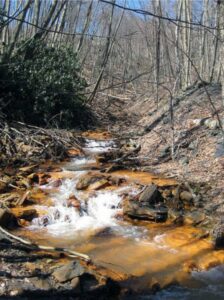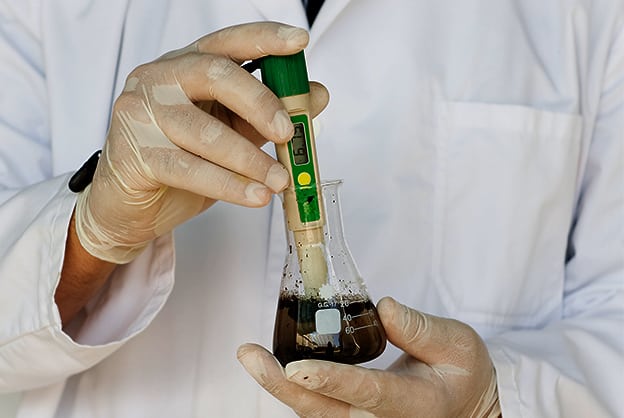Overview
STEM careers
Grade level
Time
Materials
Supplies & Equipment:
|
Consumables:
|
Relevant Terminology
pH: A measure of how acidic or basic water is.
Wastewater: Any water that has been tainted or polluted by human causes.
Potable water: Water that is fit for drinking by humans.
Introduce
GETTING READY

Acid mine drainage in a Pennsylvania stream. Credit: Michael C. Rygel/Wikimedia Commons.
Prepare polluted water by mixing water, vinegar, and vegetable oil in a gallon jug. The exact proportions are not important, but the mixture should be slightly acidic and contain some oil when poured into participants’ plastic cups. You may choose to add dirt, cocoa, or loose leaf tea to make the water look dirty. Neatly arrange the baking soda, cotton balls, coffee filters, plastic spoons, and dishwashing soap on a table for easy access.
You may choose to enlarge and print the table that explains the treatment options for participants to reference during the activity.
Research local or national water pollution issues, such as oil spills, groundwater contamination, and acid mine drainage, that you can reference during the activity.
INTRODUCTION
Ask questions to activate participants’ knowledge of water pollution:
- Can you remember a time when you heard about water pollution in the news? (Maybe some chemicals spilled into a local wetland, fertilizer from farms caused fish to die, or groundwater was contaminated when an underground storage tank cracked.)
- Do you know of any oil spills in the ocean? (Exxon Valdez, BP Deepwater Horizon.)
- What happens when accidents like these occur? (Engineers design a solution to the pollution: removal, chemical treatment, etc.)
Say: “Today we have some contaminated water. You will come up with a plan to remove the pollutants. You’ll have to weigh the pros and cons of each method to come up with the best plan, just like a real engineer. Once you have a plan, you can try it out for yourself.”
Instructions
- Each treatment plan will use no more than two treatment methods.
- The goal is to clean the water so that it may be put back into nature. The pH should be neutral and no oil should be present.
Explain the treatment options in the following table (as an option, have this table available for participants to refer to) and show the equipment needed to carry out each option.
| Treatment Name | Description | Cost | Time |
| Chemical removal (Baking soda) | Use a chemical to react with the contaminant and make it less toxic. | $$$ | Fast |
| Absorption (Cotton balls) | Use an absorbent barrier or material to treat the spill. | $ | Moderate |
| Filteration (Coffee filters) | Use filter media to separate contaminant from water. | $$$$$ | Moderate |
| Collection (Plastic spoons) | Physically remove contaminant using a method of collection. | $ | Slow |
| Surfactant (Dishwashing Soap) | Use soap or chemical to break down oils in water. | $$$ | Fast |
- Direct the participants to split into small teams. Pour contaminated water into a plastic cup for each team. Mark the water level with a marker.
- Tell teams to examine the water and figure out what the contaminants are. Use a visual observation for oil and pH paper to test acidity.
- Each team should discuss the pros and cons of each treatment method before selecting not more than two for the treatment plan.
- Allow teams up to 10 minutes to carry out the treatment plan.
- Evaluate the success of each plan by conducting a visual inspection for oil and testing with pH paper (water should be close to neutral pH, or 7.0). If time permits, allow teams to revise their plan and test again.
ACTIVITY VARIATIONS
Use a large, shallow plastic bin to recreate an oil spill in the ocean. Participants can engineer booms and skimmers out of common items to isolate and clean the spill.
Assign dollar amounts to each resource. Give the participants a budget that forces them to make choices as they can’t afford “the best” for both oil and acid removal.
Guiding questions
GUIDANCE FOR YOUNGER CHILDREN
QUESTIONS TO ASK AFTER THE ACTIVITY
- Which systems made the water cleanest?
- What else would you have tried if you had the materials you needed?
- Which system would work best if you had to clean a lot of water, like a whole lake? What about a stream?
- Does seeing how hard it is to get water clean make you think about how you could do things differently at home to keep water from getting polluted? What would you change?
GUIDANCE FOR OLDER YOUTH AND ADULTS
QUESTIONS TO ASK AFTER THE ACTIVITY
- Which systems made the water cleanest?
- Could you have devised a faster or cheaper plan? How do you think engineers decide between faster or cheaper? When would faster be better? When is cheaper better? What problems come up when you choose one over the other?
- How much water did you lose in the treatment process?
- Do you have any other ideas for how water can be cleaned, other than filtration?
- How might you change the way you manage water at home in order to generate less wastewater?
Engineering & science connections
GUIDANCE FOR YOUNGER CHILDREN
Engineering Connections
Engineers are the people who figure out how to make dirty water clean again. Whenever you flush a toilet, do dishes, or wash your clothes you create wastewater. All of the water that you use to do everyday tasks disappears into a drain, but where does the water go before it is put back into the environment? In most cases, dirty water heads to a wastewater treatment plant. There the water is placed in big tanks where it goes through a series of treatments. The solids are removed, bacteria eat the nutrients dissolved in the water, and chemicals or ultraviolet light kill microorganisms. All the solids gathered are collected, treated separately, and disposed of properly. The clean water exits the plant and is ready to be used again in rivers, lakes, and oceans and by animals and people all over the world. Engineers continue to develop more efficient ways to clean water and remove more waste.
Science Connections
The water cycle is the way water moves all over Earth’s surface, being recycled along the way. Water in the oceans (and other sources) evaporates and travels to the atmosphere as water vapor. There the vapor condenses to form clouds. The water eventually falls as rain or snow and refills our streams, rivers, and lakes.
Most of Earth’s surface is covered with oceans, but that water is too salty to drink. People need the kind of water found in rivers and lakes: freshwater. Less than half of Earth’s freshwater is found in rivers or lakes where we can use it. Most is frozen in glaciers, is too far underground to reach, or has been polluted to the point of being unsafe to drink.
GUIDANCE FOR OLDER YOUTH AND ADULTS
Engineering Connections
Whenever you flush a toilet, do dishes, or wash your laundry you create wastewater. Once it disappears into a drain, it often goes to a wastewater treatment plant where scientists and engineers have created a process to keep our waterways clean. Large solids are removed first; then the water is screened for smaller objects. The water is treated by microorganisms that eat the nutrients and other dissolved waste. These microorganisms are removed and the water is disinfected by chemicals such or hypochlorite or by ultraviolet light. The clean water is discharged to a river, stream, or even the ocean where it can be used again by animals and people. Solid wastes removed from the water are treated separately and disposed of properly. Engineers continue to develop more efficient ways to clean water.
In Israel, there is very little annual rainfall and, therefore, very little freshwater to be had. Fortunately, Israel is located next to the saltwater Mediterranean Sea. Through a process called desalination, engineers have figured out a way to take the salt out of the seawater. Now Israel has five desalination plants that provide one quarter of the country’s freshwater. This approach is very energy-intensive and expensive compared to traditional water treatment but engineers have found ways to make it more cost-effective today than it has ever been before.
Science Connections
The water cycle is the way water moves all over Earth’s surface, being recycled along the way. Water in the oceans (and other sources) evaporates and travels to the atmosphere as water vapor. There the vapor condenses to form clouds. The water eventually falls as rain or snow and recharges our streams, rivers, and lakes.
The amount of potable water on Earth is a very limited resource. Almost 70% of Earth is covered by water. However, only 2.5% of that total is freshwater, and only 1% of the freshwater is accessible to humans. The rest is frozen in glaciers, is too far underground to reach, or has been polluted to where it is not safe to drink.
The source of this material is the TeachEngineering digital library collection at www.TeachEngineering.org. All rights reserved.
www.teachengineering.org/activities/view/cub_enveng_lesson04_activity2
Supplemental content adapted for Dream Big Activities by the Carnegie Science Center.


0 Comments